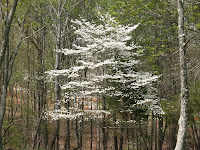


Every once on a while we find a place that is so perfect, so beautiful, and so unexpected that we shake our heads as to how we found it. Its not a destination place, like our present journey to Connecticut, but a place we stop at for the night that grabs us with its beauty. West Virginia just did it to us.
We left Mammoth Cave, and Cave City, heading to Salt Lick, Kentucky. Why, cause Renita got a chuckle out of the name Salt Lick, just as we both did with Toad Suck, Arkansas. Trusting to map quest we traveled uneventfully until we turned down Old River Road. Big mistake! Never turn on a road called "old" anything! Low lying trees blocked our way as I dodged them, trying not to damage our roof. The road narrowed before coming to an end at a highway. We turned right and drove awhile before realizing that the rv park was nowhere in sight so Renita called the place and all was well again,(luckily I only scratched the air conditioner cover).
We spent an extra day in Salt Lick planning our next weeks travel, and found a Corp of Engineers campground named Gerald Freeman. Our luck was back on. The drive into West Virginia was beautiful. Thick forests covered the hills on both sides of the road. Redbuds were in full bloom and seemed to line the highway.
Turning off the interstate we got on a road, 15, that led to the campground. It narrowed and wound and curved and turned into a tough drive pulling a 37 foot fifth wheel, but oh was it worth it!
We got a spot next to Elk River! As we set up our neighbors Cooter and Shiela came over and asked if we needed any help. We thanked them and declined. They were amazed to have people from Wyoming, and a coal miner to boot, next to them,(Renita worked for 23 years as a secretary in a Wyoming Coal mine). Later Cooters brother yelled out from his car window, "Welcome to West Virginia!" We felt at home.
It didn't take long to set up and even less to take the canoe off and get it ready!
I took it for a paddle and got it ready for the next day when Renita and I would explore the "Holler",(Cooter warned us that there were coyotes in the next holler and that they would come in after our dog).
The next day was perfect as we climbed into the canoe and headed up stream. The current was slowed by the lake and so it was an easy paddle up Elk River. We watched bluegill, bass, carp, and trout swim by. A pair of Baltimore Orioles sat patiently and let us admire them.
The stream was blocked by a rapids and a fallen tree so we headed back downstream and explored another river that emptied into the Elk. The current was also easy and we found a suspension footbridge that crossed the channel. Too soon we ran into another rapids and so we headed back floating easily with the current.
Yellow warblers flitted in the trees. A pileated woodpeckers hammered on a tree in the distance. The day was blessed as dogwoods and redbuds were at their peak and the surface of the water was lightly covered with fallen red bud blooms.
We floated further and pointed out things to one another, like two children really, but isn't that what retirement is supposed to be? A perfect day, a beautiful place, and friendly people, bless you West Virginia. Clear skies.






















